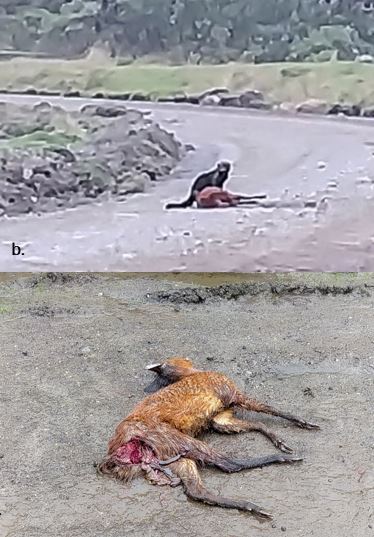Abstract
The Tayra (Eira barbara) is one of the least studied carnivores and very little is known about its natural history. The species has omnivorous diet, and is an opportunistic hunter, especially of rodents and the offspring of some arboreal species such as monkeys or sloths. In this note we report the description of a predation event done by a Tayra to a Red Brocket deer (Mazama rufina), recorded on video in the Chingaza National Natural Park, Colombia.
References
Bezerra BM, Barnett A, Souto A, Jones G. 2009. Predation by the tayra on the common marmoset and pale-throated three-toed sloth. Japan Ethological Society and Springer 27:91-96. https://doi.org/10.1007/s10164-008-0090-3
Cuarón AD, Reid F, Helgen K, González-Maya JF. 2016. Eira barbara. The IUCN Red List of Threatened Species 2016. https://dx.doi.org/10.2305/IUCN.UK.2016-1.RLTS.T41644A45212151.en
Emmons LH, Feer F. 1999. Mamíferos de los bosques húmedos de América Tropical, una guía de campo. Editorial FAN. Santa Cruz de la Sierra.
Galef BG Jr, Mittermeier RA, Bailey RC. 1976. Predation by the tayra (Eira barbara). Journal of Mammalogy, 57:760–761. https://doi.org/10.2307/1379450
González-Maya JF, Zárrate-Charry DA, Vela-Vargas IM, Jiménez-Alvarado JS, Gómez-Hoyos D. 2015. Activity patterns of Tayra Eira barbara populations from Costa Rica and Colombia: evidence of seasonal effects. Revista Biodiversidad Neotropical 5:96–104.
González-Maya JF, Cepeda AA, Belant JL, Zárrate-Charry DA, Balaguera-Reina SA, Rodríguez-Bolaños A. 2011. Research priorities for the small carnivores of Colombia. Small Carnivore Conservation. 44:7-13.
González-Maya JF, Schipper J, Benítez A. 2009. Activity patterns and community ecology of small carnivores in the Talamanca region, Costa Rica. Small Carnivore Conservation. 41: 9-14.
Konecny MJ. 1989. Movement patterns and food habits of four sympatric carnivore species in Belize, Central America. In: Redford K & Eisenberg J, editors. Advances in Neotropical mammalogy. Sandhill Crane Press, Gainesville, Florida. p. 243-264.
Lizcano D, Alvarez SJ. 2016. Mazama rufina. The IUCN Red List of Threatened Species 2016: e.T12914A22165586. https://dx.doi.org/10.2305/IUCN.UK.2016-2.RLTS.T12914A22165586.en
Moynihan M. 1970. Some behavior patterns of platyrrhine monkeys II. Saguinus geoffroyi and some other tamarins. Smithsonian Contributions to Zoology, 28:1-77.
Muniz A. 2000. Attempted predation on Brazilian rabbit (Sylvilagus brasiliensis - Lagomorpha: Leporidae) by Tayra (Eira barbara-Carnivora: Procyonidae). Revista de Biología Tropical 48(1):267-268.
Presley SJ. 2000. Eira barbara. Mammalian Species, 636: 1-6. https://doi.org/10.1644/1545-1410(2000)636<0001:EB>2.0.CO;2
Shaw E. 2018. Mustelid vs. primate: Yellow throated marten pair kills rhesus macaque. EarthTouch News Network. https://www.earthtouchnews.com/natural-world/predator-vs-prey/mustelid-vs-primate-yellow-throated-marten-pair-kills-rhesus-macaque/ (Consultado: 22/07/2020)
Skutch A. 1971. A Naturalist in Costa Rica. Univ. Florida Press, Gainesville.
Sunquist ME, Sunquist F, Daneke DE. 1989. Ecological separation in a Venezuelan Llanos carnivore community. In: Redford K & Eisenberg J, editors. Advances in Neotropical mammalogy. Sandhill Crane Press, Gainesville, Florida. p. 197–232.
Venturini TS, Gonçalves AL, Silva dos Santos L. 2016. Predation attempt and abnormal coat coloration of the tayra (Eira barbara) in the Brazilian Central Amazon, Studies on Neotropical Fauna and Environment, 51:3, 231-234, https://doi.org/10.1080/01650521.2016.1227137
Villa RB. 1948. Mamíferos del Soconusco, Chiapas. Anales del Instituto de Biología, México, 19: 485-528.
Yensen E, Tarifa T. 2003. Galictis vittata. Mammalian Species, 727: 1-8. https://doi.org/10.1644/0.727.1

This work is licensed under a Creative Commons Attribution-ShareAlike 4.0 International License.






